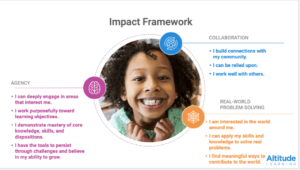Supporting Statewide Change Through Microgrants to Families

CARES Act funding encourages states to create a system for providing microgrants to families to ensure they have access to the technology and educational services they need to advance their learning. This funding creates the opportunity to shift some of the most basic power dynamics, and address some of the persistent infrastructure constraints that have held the education system static for a generation. It is also fraught with risk, including the potential to exacerbate the very inequities it seeks to address. There are specific steps leaders can take to maximize the likelihood of success.
Direct access and full transparency
In many places, the pandemic has exposed the extent to which access to resources limits learner and community engagement. After one of the largest-scale forced experiments in public education history, few SEAs and LEAs are satisfied with their first pass at a digital-first education system. The vision for this priority is to create a system that facilitates parent educational choice while also expanding access to the basic technology infrastructure families need to effectively access current and future virtual learning options.
Envisioning an online microgrant system
The end result would be a system that creates a state-level market for parents to select and spend their microgrant funds across a variety of options, suitable to their children and their own technology needs. It would empower rural communities to greatly improve connectivity, and provide students and families more agency and ability to access the education options that work best for them.
In our vision, it would also expand access to programming that is learner-centered. This means that it would elevate and expand access to learning that is personalized, authentic, competency-based, and open-walled.
To achieve this, a statewide microgrant system would have to function at three levels. First, it would need to include a platform accessible to parents and responsive to known and immediate needs. Within this platform, it would need to provide options that fit community technology and learning demands. Finally, it would need to monitor usage, troubleshoot access challenges, and seek to inform the evolution of the network by linking this learning system into other state infrastructures like course credits, grading systems, and public matriculation.
Risk of unintended consequences
Clearly, this vision is a dramatic departure from the status quo. But poorly designed or shoddily implemented, a statewide microgrant system risks worsening some of the most troubling elements of the system students and families have experienced over the past four to six months. Most important is the risk of widening existing gaps in access and outcomes.
Towards a learner-centered system
While a microgrant system may seem like an operational intervention, it represents a potential shift in power and agency within a system that has been institution and adult-centered. This shift only goes so far if the options available to families simply recreate the institutional / adult-centered experience in a new format. Consider how the design and implementation of the microgrant system can promote access to options that are learner-centered and facilitate programming that was designed to work in a virtual-first environment.
A new vision for student outcomes
Also consider how the success of the microgrant system will be measured. Defining this impact framework upfront will go a long way towards preventing simply reshuffling access to traditional programming in a new format. Ultimately the public will view the success of the system in relation to the outcomes communicated from the beginning. The microgrant program can be a step towards shifting an entire system towards a more learner-centered and complete view of student success.
Getting microgrants right
Especially given the urgent, ambitious timeline the microgrant system leaders benefit from practicing the principles of learner-centered leadership, placing student and parent voices, experiences, and aspirations at the center of the design. Leaders should also pinpoint where to innovate, being clear upfront about which elements of the current system they are seeking to change through the microgrant process, and which they are comfortable holding constant. Beyond these basics, here are four specific steps to incorporate into SEA plans:
Think differently about community and customer engagement.
This funding is targeting populations who have not been effectively served by the traditional education system. Engaging “the most disadvantaged students, and parents” will require new ways of bringing learners and parents into the work. Instead of traditional task forces and stakeholder committees, focus on more modern, technology-enabled methods of understanding user needs, allowing the user to define value. This includes investing in user experience research and design, leveraging mobile tools like text and social media, and releasing minimum viable products to get direct feedback from users.
Create the future direct-to-parent infrastructure.
Focus relentlessly on the target users during design and implementation. Keep this focus narrow, and design something that meets their needs. Needs may include baseline communication about what might be possible within the microgrants and how families may use this type of savings account for their children. Once they are engaged and successful it will be easier to expand to meet the needs of others. Along the way, optimize for mobile technology. The majority of users will be filling out forms and engaging from their mobile devices. Get the basics right, and be careful with assumptions. For example, many students may not have their own email addresses so a system that requires that would be problematic.
Include effective adult learning from day 1
Getting ahead of the capacity building it takes to effectively deliver and sustain systems change is always one of the most challenging parts. Build in feedback loops, incentives, and high quality self-guided learning into the system design so that users are able to learn quickly and effectively at the moment they need it. Implementing these local spending accounts will need to change over time as usage increases. Parents may start by accessing computer hardware and hotspots early on and then move towards other services. Staying in consistent conversations with users will support successful innovation and adult capacity building.
Modernize approach to assessment and progress monitoring
Take advantage of this moment to move beyond the traditional, summative, and narrowly focused assessment system to one that monitors competency, interests, and learning patterns. For the microgrant system, this means staying engaged with learners and families, understanding partner offerings and learning trajectories, and possible gaps of what might be missing across your microgrant learner portfolio. Depending on the focus of your microgrants and how your state adopts this network, you may also want to consider how student learning translates into changes within your course credit and promotion systems.
Operationalizing this strategy
The above points seek to clarify the vision for what a successful microgrant system might look like, how to avoid getting it wrong, and what needs to be included in order to get it right. But how should SEAs approach implementation? How should they be thinking about the process of delivering this kind of system on an extremely rapid timeline?
About the Moving Forward Together coalition
The Moving Forward Together coalition coalesced around the opportunity to build an agile coalition to support SEAs in responding to the current crisis in a way that helps SEAs create a better, more learner-centered system. Anchoring this coalition are:
- Altitude Learning which provides learner-centered technology solutions to support competency-based, personalized, and authentic learning both through LEAs and direct to families through Altitude Learning @Home. Leaders in learner-centered technology and practice, Altitude Learning’s staff literally wrote the books on Learner Centered Leadership and Learner Centered Innovation.
- Getting Smart, a prolific thought leadership in learning innovation firm, is uniquely situated to help LEAs establish your approach to microgrants, target local communities, and lead this dramatic shift in access and resources across entire states. Getting Smart provides a variety of key implementation supports from program design to communications.
The coalition is led by Devin Vodicka, Chief Impact Officer at Altitude and former CA Superintendent of the Year, and Tom Vander Ark, CEO at Getting Smart, former Superintendent in WA State, and the first Executive Director of Education for the Bill & Melinda Gates Foundation.
Other “Moving Forward Together” partners will be pulled in as needed to bring their unique expertise to bear supporting SEA plans. They include: Digital Promise, NGLC, Education Reimagined, KnowledgeWorks, former superintendents, content and assessment experts, and workforce and higher education consultants.
Unique capabilities
Due to the diversity, depth, and breadth of coalition partners, the Moving Forward Together coalition can help pursue a microgrant strategy that mitigates risk and maximizes upside potential. Specifically, the coalition can provide: Input and advice; Strategy and implementation; Technology; Design; and Talent development.
Compliance, convenience and cost
In addition to bringing lessons from successes and failures from the leading edge of innovation, coalition leaders understand the constraints and pressures facing SEAs and LEAs. Implementing a microgrant strategy will require significant attention to:
- Meeting state and federal requirements that still apply to this learning ecosystem;
- Bringing together a diverse coalition of experts and service providers; and
- Doing all of this at a lower cost than high-end consulting firms typically charge.
The Moving Forward coalition formed to bring together and apply the best thinking and learning from the field in a way that accounts for compliance-related constraints, provides a convenient, one-stop-shop for SEA leaders, and delivers these services at a competitive rate while engaging experienced practitioners.
For more information on the coalition contact Caroline.
For more, see:
- 3 Ways Leaders Can Create the Conditions for Deeper Learning
- Choosing the Right Tools for Amplifying Learning Through PBL
- A Path to Higher Education and Employment for Refugees
Stay in-the-know with innovations in learning by signing up for the weekly Smart Update.








0 Comments
Leave a Comment
Your email address will not be published. All fields are required.